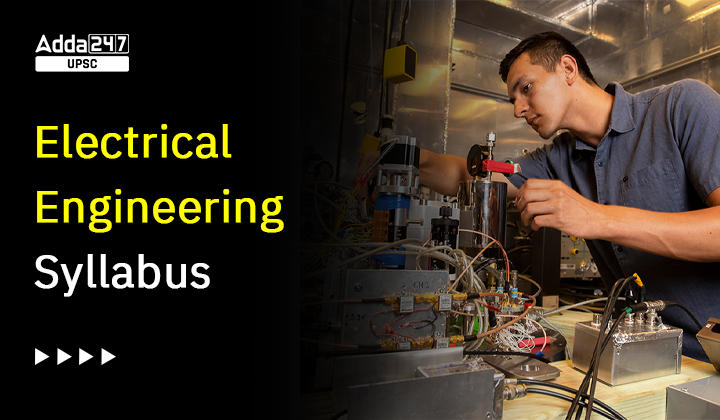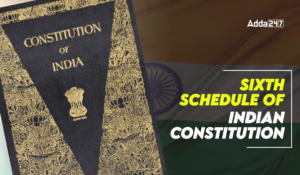UPSC Electrical Engineering Syllabus 2024: The UP PSC Electrical Engineering Syllabus consists of various subjects such as Analog and Digital Electronics, Microprocessors, Power Systems, and more. Alongside Electrical Engineering, UPSC also offers two other technical subjects: Civil Engineering and Mechanical Engineering.
The extensive coverage of the UPSC Electrical Engineering Syllabus demands a well-planned strategy from candidates. Those with a background and interest in this subject are advised to opt for it, as it can be challenging for candidates without prior knowledge to cover the vast syllabus of UPSC Electrical Engineering Optional.
UPSC Electrical Engineering Syllabus 2024: Overview
UPSC Electrical Engineering Syllabus: According to the table, the exam pattern of each paper of the UPSC IAS Electrical Engineering Syllabus is assigned 250 marks, a total of 500 marks. Candidates must aim for a high score to significantly impact their overall performance in the UPSC Exam. Understanding the UPSC Electrical Engineering Syllabus is the initial step towards excelling in this subject.
Candidates who have a background in electronics or electrical engineering during their graduation or master’s degree may find the UPSC Electrical Engineering Optional Syllabus relevant. The syllabus consists of two papers, namely Paper 1 and Paper 2. The time duration for both exams is 3 Hours.
UPSC Electrical Engineering Exam Pattern
|
| Topic |
Marks |
Duration |
| UPSC Electrical Engineering Optional Syllabus Paper 1 |
250 |
3 Hours |
| UPSC Electrical Engineering Optional Syllabus Paper 2 |
250 |
Download PDF: UPSC IAS Electrical Engineering Syllabus
UPSC Electrical Engineering Syllabus 2024 for Mains (Optional Paper-I)
UPSC IAS Electrical Engineering Syllabus: Candidates can check the provided table below for UPSC Electrical Engineering Optional Syllabus Paper 1.
| Topics |
Sub-Topics |
| Circuits Theory |
- Circuit components, network graphs, KCL, KVL, circuit analysis methods: nodal analysis, mesh analysis, basic network theorems, and applications.
- Transient analysis: RL, RC, and RLC circuits, sinusoidal steady-state analysis, resonant circuits, coupled circuits, and balanced 3-phase circuits. two-port networks.
|
| Signals and Systems |
- Representation of continuous-time and discrete-time signals and systems.
- LTI systems, convolution, impulse response, time-domain analysis of LTI systems based on convolution and differential/difference equations.
- Fourier transforms, Laplace, transform, Z-transform, Transfer function.
- Sampling and recovery of signals DFT, FFT Processing of analog signals through discrete-time systems.
|
| E.M. Theory |
- Maxwell’s equations, wave propagation in bounded media.
- Boundary conditions, reflection, and refraction of plane waves.
- Transmission lines: traveling and standing waves, impedance matching, Smith chart.
|
| Analog Electronics |
- Characteristics and equivalent circuits (large and small-signal) of Diode, BJT, JFET, and MOSFET.
- Diode circuits: Clipping, clamping, rectifier.
- Biasing and bias stability. FET amplifiers. Current mirror.
- Amplifiers: single-and multi-stage, differential, operational feedback, and power. Analysis of amplifiers, a frequency response of amplifiers. OPAMP circuits.
- filters, sinusoidal oscillators: criterion for oscillation, single-transistor, and OPAMP configurations.
- Function generators and wave-shaping circuits. Linear and switching power supplies.
|
| Digital Electronics |
- Boolean algebra, minimization of Boolean functions, logic gates, digital IC families (DTL, TTL, ECL, MOS, CMOS).
- Combinational circuits: arithmetic circuits, code converters, multiplexers, and decoders.
- Sequential circuits: latches and flip-flops, counters and shift registers.
- Comparators, timers, multivibrators. Sample and hold circuits, ADCs, and DACs.
- Semiconductor memories. Logic implementation using programmable devices (ROM, PLA, FPGA).
|
| Energy Conversion |
- Principles of electromechanical energy conversion: Torque and emf in rotating machines.
- DC machines: characteristics and performance analysis, starting and speed control of motors.
- Transformers: principles of operation and analysis, regulation, efficiency, 3-phase transformers.
- 3-phase induction machines and synchronous machines: characteristics and performance analysis, speed control.
|
| Power Electronics and Electric Drives |
- Semiconductor power devices: diode, transistor, thyristor, triac, GTO, and MOSFETstatic characteristics and principles of operation, triggering circuits, phase control rectifiers.
- Bridge converters: fully-controlled and half-controlled, principles of thyristor choppers and inverters, DC-DC converters, Switch mode inverter, basic concepts of speed control of dc and ac motor drives applications of variable-speed drives.
|
| Analog Communication |
- Random variables: continuous, discrete, probability, probability functions. Statistical averages, probability models.
- Random signals and noise: white noise, noise equivalent bandwidth, signal transmission with noise, signal to noise ratio.
- Linear CW modulation: Amplitude modulation: DSB, DSB-SC, and SSB. Modulators and Demodulators.
Phase and Frequency modulation: PM & FM signals, narrows band FM, generation & detection of FM and PM, Deemphasis, Preemphasis.
- CW modulation system: Superheterodyne receivers, AM receivers, communication receivers, FM receivers, phase-locked loop, SSB receiver Signal to noise ratio calculation or AM and FM receivers.
|
UPSC Electrical Engineering Syllabus 2024 for Mains (Optional Paper-II)
UPSC IAS Electrical Engineering Syllabus: Candidates can check the provided table below for UPSC Electrical Engineering Optional Syllabus Paper 2.
| Topics |
Sub-Topics |
| Control Systems |
- Elements of control systems, block-diagram representations, open-loop & closed-loop systems, principles and applications of feedback.
- Control system components. LTI systems: time-domain and transform-domain analysis.
- Stability: Routh Hurwitz criterion, root-loci, Bode-plots, and polar plots, Nyquist’s criterion, Design of lead-lad compensators.
- Proportional, PI, PID controllers. State-variable representation and analysis of control systems.
|
| Microprocessors and Microcomputers |
- PC organization, CPU, instruction set, register setting diagram, programming, interrupts Memory interfacing, I/O interfacing, and programmable peripheral devices.
|
| Measurement and Instrumentation |
- Error analysis, measurement of current-voltage, power, energy, power factor, resistance, inductance, capacitance and frequency, bridge measurements. Signal conditioning circuit.
- Electronic measuring instruments: multimeter, CRO, digital voltmeter, frequency counter, Q-meter, spectrum analyzer, distortion-meter.
- Transducers: thermocouple, thermistor, LVDT, strain-gauge, piezo-electric crystal.
|
| Power Systems |
- Analysis and Control: Steady-state performance of overhead transmission lines and cables, principles of active and reactive power transfer and distribution, per-unit quantities, bus admittance and impedance matrices, load flow, voltage control and power factor correction, economic operation, symmetrical components, analysis of symmetrical and unsymmetrical faults.
- Concepts of system stability: swing curves and equal area criterion. Static VAR system. Basic concepts of HVDC transmission.
|
| Power System Protection |
- Principles of overcurrent, differential, and distance protection. Concept of solid-state relays.
- Circuit breakers. Computer-aided protection: Introduction, line, bus, generator, transformer protection, numeric relays, and application of DSP to protection.
|
| Digital Communication |
- Pulse code modulation (PCM), differential pulse code modulation (DPCM), delta modulation (DM), Digital modulation, and demodulation schemes: amplitude, phase, and frequency keying schemes (ASK, PSK, FSK).
- Error control coding: error detection and correction, linear block codes, convolution codes.
- Information measure and source coding. Data networks, 7-layer architecture.
|
UPSC Electrical Engineering Exam Preparation Strategy
Candidates must follow the preparation strategy for the UPSC Electrical Engineering exam mentioned below.
- To ensure comprehensive coverage of the UPSC Electrical Engineering Optional Syllabus, candidates are advised to print out a copy of the syllabus. This will help them avoid missing any crucial topics and prevent wasting time and effort on unrelated subjects.
- Candidates must focus on solving numerical problems alongside studying the theoretical aspects. Striking a balance between both aspects will prove beneficial.
- Reviewing previous years’ UPSC question papers can provide valuable insights into which topics from the Electrical Engineering syllabus are of utmost importance.
- Creating concise notes is essential due to the vastness of the UPSC Electrical Engineering Optional Syllabus. These notes can serve as a handy tool for quick revision, providing a final touch before the exam.

Sharing is caring!



 UPSC Eligibility Criteria 2024- Check Ag...
UPSC Eligibility Criteria 2024- Check Ag...
 OPSC OCS Notification 2024, Check Exam D...
OPSC OCS Notification 2024, Check Exam D...
 Sixth Schedule of Indian Constitution, B...
Sixth Schedule of Indian Constitution, B...







